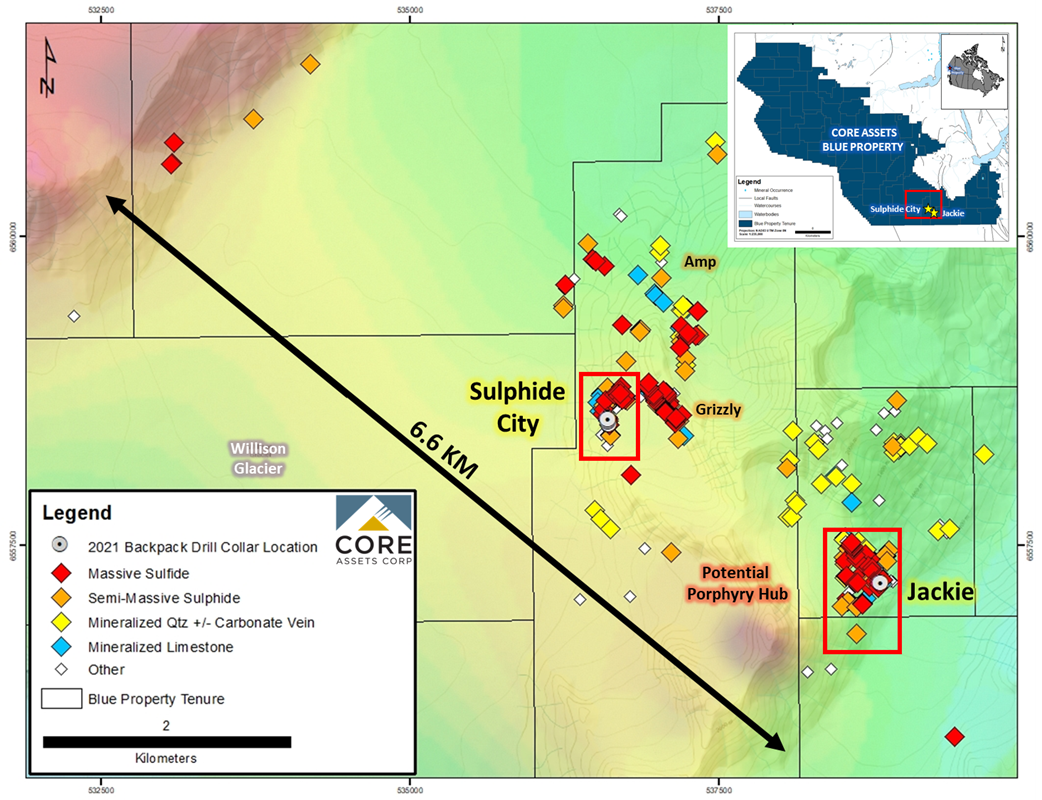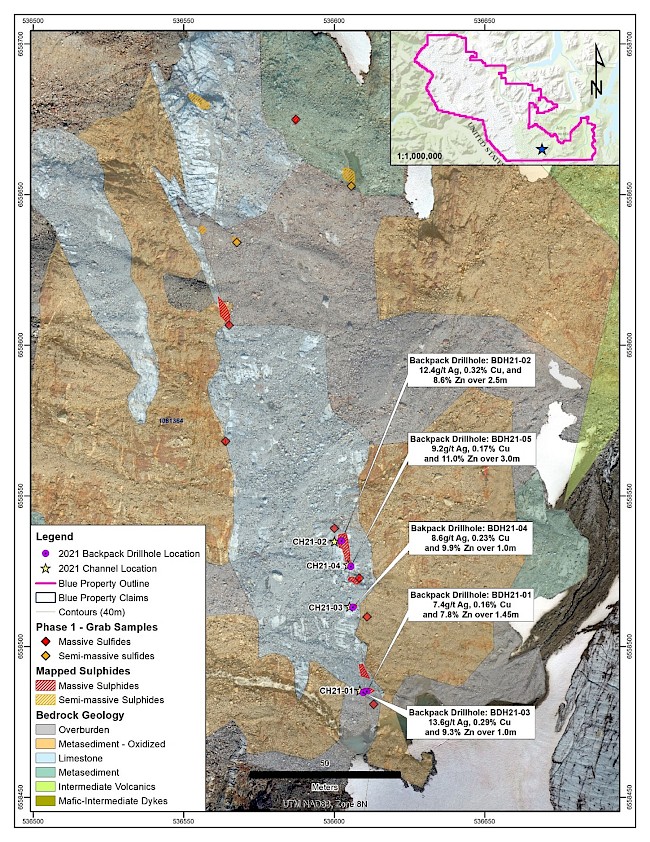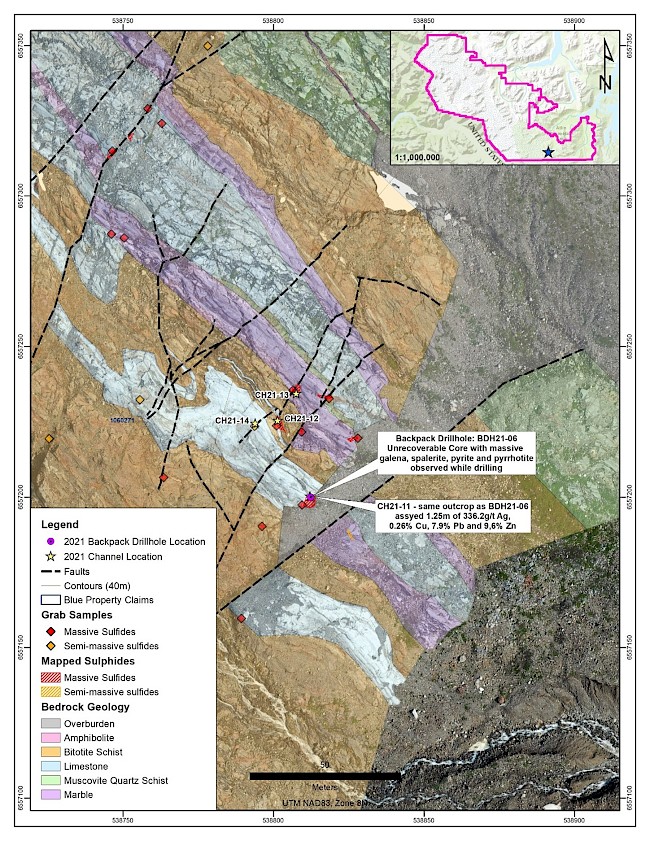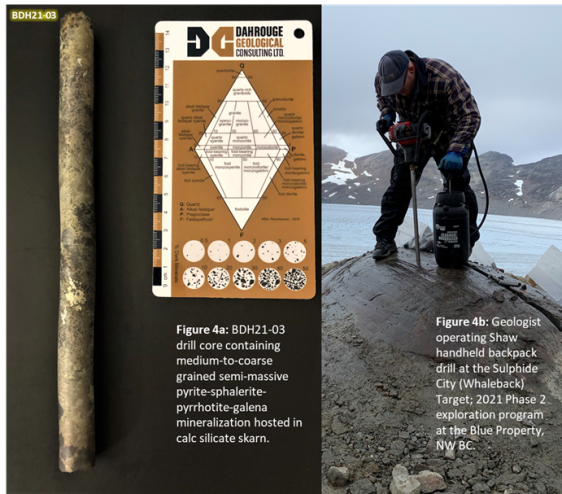Vancouver, March 14, 2022 – Core Assets Corp., (“Core Assets” or the “Company”) (CSE:CC) (FSE:5RJ) (OTC.QB:CCOOF) is pleased to announce results from six backpack (25mm diameter) drill holes completed during 2021 Phase 2 exploration efforts at the Sulphide City (Whaleback) and Jackie targets on the Company’s Blue Property (the “Property”), located in the Atlin Mining District of British Columbia.
Highlights
● The 2021 backpack drilling campaign at the Blue Property was designed to test the extent of exposed massive-to-semi massive sulphide mineralization at depth. Six, 25mm diameter drill holes were collared within zones of skarn (Sulphide City – Whaleback) or carbonate replacement mineralization (CRM; Jackie Target) that were originally tested by channel sampling during the Phase 2 exploration program.
● All drill core samples submitted (1m to 3m intervals) assayed >7g/t Ag, >0.16% Cu, and >7% Zn and all holes intercepted medium-to-coarse grained, calc silicate-hosted, semi-massive sulphide or massive CRM over their entire lengths and ended in mineralization, indicating that these occurrences exhibit grade consistency and continuity over shallow depths as well as along surface (Table 1).
● BDH21-02 targeted semi-massive skarn mineralization previously tested in CH21-02 (Figure 2) and returned 12.41g/t Ag, 0.32% Cu, and 8.56% Zn over 2.5m; including 1.05m of 18.5g/t Ag, 0.46% Cu, and 10.15% Zn.
● BDH21-03 intercepted 1m of skarn mineralization grading 13.6g/t Ag, 0.29% Cu, and 9.35% Zn (Figure 2).
● BDH21-05 targeted calc-silicate hosted semi-massive skarn mineralization and assayed 9.2g/t Ag, 0.17% Cu, and 11% Zn over 3m (Figure 2).
● One backpack drill hole, collared to test CRM at the Jackie Target (CH21-11), intercepted 3m of soft, massive Galena (PbS – hardness of 2.75) with lesser sphalerite (ZnS), pyrite, and pyrrhotite (75% visual mineralization), and was unrecoverable (Figure 3). Recovery will be improved using large diameter core size during 2022 drilling program. Samples collected from CH21-11 previously returned 1.25m of 336g/t Ag, 0.26% Cu, 7.9% Pb, and 9.6% Zn, including 0.35m of 851g/t Ag, 0.29% Cu, >20% Pb, and 9.7% Zn (See News Release - January 31, 2022).
● The 2021 Discovery Zone (Grizzly, Sulphide City, and Amp targets) combined with the Silver Lime Prospect (Jackie Target) currently defines a 3.7km by 1.8km area of tight, high-grade carbonate replacement (CRM) and skarn mineralization within the broad 6.6km mineralized corridor that remains open. Unlike vein-hosted deposits, carbonate replacement deposits (CRDs) typically manifest as continuous sulphide bodies over multi-kilometre-scales that broaden with depth and demonstrate continuity back to the source.
Core Assets’ President and CEO Nick Rodway comments, “Despite the backpack-style drilling depth limitations, the results from the low-hanging skarn and carbonate replacement occurrences at the 2021 Discovery Zone demonstrate that grade is consistently elevated along surface and at shallow depths. Our next steps will focus on incorporating property-wide, reprocessed geophysical data, and interpreting this information with respect to historic drilling, recent surficial geochemistry, and geological mapping.”

Figure 1: Location of the Jackie and Sulphide City targets (red squares), within the extensive 6.6-kilometre mineralized corridor at the Blue Property. All historic and recent surficial samples, as well as the locations of the 2021 backpack drill collars are plotted.

Table 1: Backpack Drilling Highlights from the Sulphide City (Whaleback) Target. * Values indicate length weighted average values of full-core samples and true widths are unknown at this time. Bolded interval lengths indicate full backpack drill hole lengths to end of hole (EOH). BDH21-06, collared at the Jackie Target was not recovered due to equipment limitations.

Figure 2: Location and highlights of the 2021 backpack drilling campaign at the Sulphide City (Whaleback) Target, Blue Property, NW BC.

Figure 3: Location and highlights of the 2021 backpack drilling and channel sampling campaigns at the Jackie Target, Blue Property, NW BC.
2021 Backpack Drilling at the Sulphide City & Jackie targets
The 2021 backpack drilling campaign was designed to test the depth extent of target mineralization within the central Blue Property. Six, shallow backpack drill holes (25mm core diameter) were collared proximal to Phase 2 channel locations that previously tested the grade continuity of massive-to-semi massive carbonate replacement or skarn mineralization along surface. The Jackie Target, part of the Silver Lime Prospect, consists of numerous massive-to-semi-massive sulphide occurrences that measure up to 30 metres long and 6 metres wide. Many sulphide occurrences at Jackie are clustered and hosted within mapped NE-SW trending faults and fault splays. These fault-hosted sulphide bodies are interpreted as “spokes” that typically broaden at depth and express continuity back towards a causative intrusion. Backpack drilling efforts at Jackie, although unrecoverable, proved that massive, galena-rich CRM extends to depths of at least 3m. Skarn and CRM showings at the Sulphide City Target are characterized by multiple, Zn-Cu-Ag semi-massive to massive sulphide occurrences measuring up to 40 metres along strike and 8 metres wide. All shallow backpack drill holes completed at Sulphide City (Whaleback) in 2021 intersected calc silicate skarn-hosted semi-massive sulphide over their full lengths ranging from 1 to 3m depth. Overall, Phase 2 backpack drilling and channel sampling efforts at the central Blue Property prove that numerous carbonate replacement and skarn-hosted sulphide occurrences exhibit consistent grade and continuity along surface and for up to 3m at depth.

Following the Hub & Spoke model (i.e., Bingham Canyon, Utah, USA), high-temperature, ore-bearing fluids are derived from proximal intrusive phases (the “Hub”). The ore fluids migrate away from the heat source along structurally controlled networks of faults and fractures. During fluid propagation, ore fluids mix with other fluid sources (i.e., meteoric/connate waters or basin brines). Sulphide bodies (“spokes”) are then precipitated through a neutralizing, dissolution replacement reaction between the ore fluid and carbonate-rich lithologies (i.e., limestone).
QA/QC, Sample Preparation & Drill Limitations
A Shaw backpack drill was utilized to drill the 25mm core holes. The backpack drill has a depth limitation of approximately 3 metres which was reached on drill hole BDH21-05 and BDH21-06. The drill was also limited when harder material was intersected with drill hole BDH21-01 hitting refusal at 1.45m depth when a quartz vein was encountered. The backpack drill samples were logged and placed in pre-labelled sample bags. Collar locations were collected using a handheld GPS. All drill holes were vertical, apart from BDH21-06 which was drilled at 270/45°, and from which no core was recovered. The core was not recovered likely due to surficial oxidation and the small diameter of the core which resulted in the soft oxidized massive sulphide material pulverizing. Core recovery in drill holes BDH21-01 to BDH21-05 was 100%. Samples were stored in 5-gallon pails in a secure location until ready for shipment. Two quartz blanks were submitted as part of internal quality assurance and quality control procedures. All full-core samples and quartz blanks were shipped by ground to ALS Geochemistry in Whitehorse, YT for crushing and sample preparation. Samples were then shipped to ALS Geochemistry in North Vancouver, BC for multielement analysis (including Ag) by four-acid digestion with ICP-AES instrumentation (package ME-ICP61) and Au, Pd, Pt by fire assay (package PGM-ICP27). Any overlimit for Ag, Cu, Pb and Zn was analyzed using the applicable assay package ME-OG62.
National Instrument 43-101 Disclosure
Nicholas Rodway, P.Geo, (Licence #46541) is President, CEO and Director of the Company, and qualified person as defined by National Instrument 43-101. Mr. Rodway supervised the preparation of the technical information in this news release.
About Core Assets Corp.
Core Assets Corp. is a Canadian mineral exploration company focused on the acquisition and development of mineral projects in British Columbia., Canada. The Company currently holds 100% title ownership in the Blue Property, which covers a land area of 109,994.4 ha (~1,010 km²). The project lies within the Atlin Mining District, a well-known gold mining camp located in the unceded territory of the Taku River Tlingit First Nation and the Carcross/Tagish First Nation. The Blue Property hosts a major structural feature known as The Llewellyn Fault Zone (“LFZ”). This structure is approximately 140 km in length and runs from the Tally-Ho Shear Zone in the Yukon, south through the Blue Property to the Alaskan Panhandle Juneau Ice Sheet in the United States. Core Assets believes that the south Atlin Lake area and the LFZ has been neglected since the last major exploration campaigns in the 1980's. The LFZ plays an important role in mineralization of near surface metal occurrences across the Blue Property. The past 50 years have seen substantial advancements in the understanding of porphyry, skarn, and carbonate replacement type deposits both globally and in BC’s Golden Triangle. The company has leveraged this information at the Blue Property to tailor an already proven exploration model and believes this could facilitate a major discovery. Core Assets is excited to become one of Atlin Mining District’s premier explorers where its team believes there are substantial opportunities for new discoveries and development in the area.
On Behalf of the Board of Directors
CORE ASSETS CORP.
“Nicholas Rodway”
President & CEO
Tel: 604.681.1568
Neither the Canadian Securities Exchange nor its Regulation Services Provider (as that term is defined in the policies of the CSE) accepts responsibility for the adequacy or accuracy of this release.
FORWARD LOOKING STATEMENTS
Statements in this document which are not purely historical are forward-looking statements, including any statements regarding beliefs, plans, expectations, or intentions regarding the future. Forward looking statements in this news release include the Company’s future objective of becoming a premier explorer; that the Company’s exploration model can facilitate a major discovery on the Blue Property; that the Blue Property is prospective for copper, zinc and silver; that Core Assets will undertake additional exploration activity on the Blue Property; and that the Blue Property has substantial opportunities for a discovery and development; . It is important to note that the Company's actual business outcomes and exploration results could differ materially from those in such forward-looking statements. Risks and uncertainties include that further permits may not be granted timely or at all; the mineral claims may prove to be unworthy of further expenditure; there may not be an economic mineral resource; certain exploration methods that we thought would be effective may not prove to be in practice or on our claims; economic, competitive, governmental, geopolitical, environmental and technological factors may affect the Company's operations, markets, products and prices; our specific plans and timing drilling, field work and other plans may change; we may not have access to or be able to develop any minerals because of cost factors, type of terrain, or availability of equipment and technology; and we may also not raise sufficient funds to carry out or complete our plans. Additional risk factors are discussed in the section entitled "Risk Factors" in the Company's Management Discussion and Analysis for its recently completed fiscal period, which is available under Company's SEDAR profile at www.sedar.com. Except as required by law, the Company will not update or revise these forward-looking statements after the date of this document or to revise them to reflect the occurrence of future unanticipated events.
